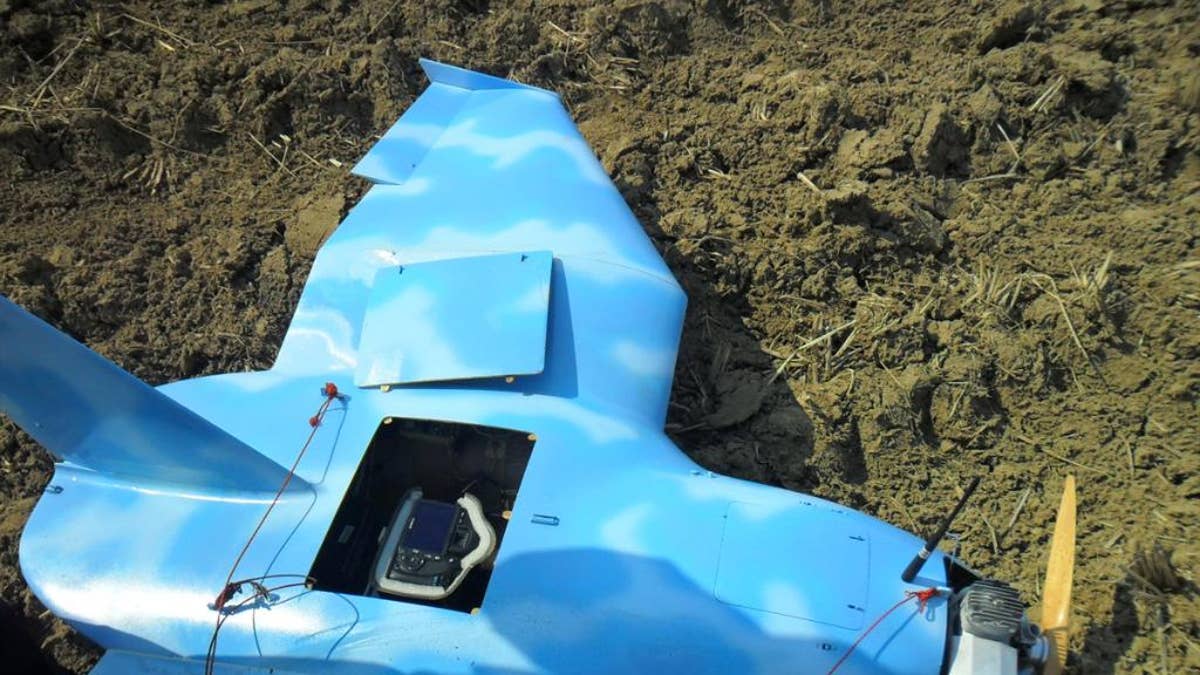
FILE - In this file photo provided on Wednesday, April 2, 2014 by the South Korea Defense Ministry, an unmanned drone which was found last week in Paju, a South Korean city near the land border with North Korea. South Korean experts say two small drones believed to have been flown across the border by the North amid rising military tensions were crude and decidedly low-tech - with cameras available on the Internet for hundreds of dollars - but underscore a potential new threat that must be taken seriously. (AP Photo/South Korea Defense Ministry, File) (The Associated Press)
SEOUL, South Korea – South Korean experts say two small drones believed to have been flown across the border by the North amid rising military tensions were crude and decidedly low-tech — equipped with cameras available on the Internet for hundreds of dollars — but underscore a potential new threat that must be taken seriously.
North Korea has recently been touting its drone program, a relatively new addition to its arsenal. It has prominently displayed large drone-like aircraft in military parades. According to the North's state-run media, leader Kim Jong Un watched a drone attack drill on a simulated South Korean target last year.
If the South Korean claims that the drones were from the North are true, they would be the first solid, public evidence that North Korea is using its drones to infiltrate South Korean airspace, including the skies over the capital Seoul and its surroundings.
The captured drones were basic, at best.
One crashed in Paju, a city near the land border with North Korea, on March 24. The other crashed on Baengnyeong Island on Monday. South Korean defense officials say they are rudimentary, equipped with Japanese-made cameras capable of taking only still photos that cannot be transmitted in real time but must instead be retrieved.
The Paju drone was equipped with a Canon camera and the other one carried a Nikon camera. Defense Ministry spokesman Kim Min-seok said the Cannon camera can be bought for about 1 million won (about $950) on the Internet.
Both drones were painted sky blue, probably cost only a few thousand dollars to build and were 140 centimeters (55 inches) and 180 centimeters (71 inches) long — giving them the appearance of the large model planes associated more with hobbyists than militaries.
Kim, in a briefing Thursday, said lettering on the battery of the drone found at Paju and other forensic evidence suggest it was of North Korean origin. He said it had enough fuel to return to North Korea. Defense officials say it took 193 photos of Seoul, Paju and other areas, but refused to disclose which specific sites.
The second drone took photos of two front-line islands — Socheong and Daecheong — near the disputed western sea boundary with North Korea.
Kim said the first drone probably crashed due to an engine problem and the second ran out of fuel. They evaded detection because they are so small and made of polycarbonate.
While the capture of the two surveillance drones appears to offer a rare glimpse into the North's technology, analysts stress they do not necessarily represent the best unmanned aerial vehicles the North can field. They also note the captured drones — and anything else the North is likely to have — are a far cry from the U.S.-made Global Hawk unmanned aerial vehicle, which South Korea plans to introduce to its military in the near future, at about $208 million a pop.
Analyst Go Myong-Hyun at the Asan Institute for Policy Studies in Seoul said that although the captured drones would be useless on cloudy days or at night, they point to the North's efforts to develop an "asymmetrical strategy to achieve maximum effect at the minimum cost."
The claim that the drones were flown by the North was announced earlier this week just after North and South artillery batteries fired barrages into each other's territorial waters in a tense but in the end harmless game of military tit-for-tat.
"Our government and military were not aware of the flight of the drone even when it was on a potentially dangerous mission," the mass-circulation JoongAng Ilbo said in an editorial. "The drones' technology was not so impressive, but it could be used for terror if improved — either for a kamikaze attack or an attack with biological or chemical weapons."
Another major newspaper, the Chosun Ilbo, ran a front-page photo showing what it said was an aerial shot taken by the Paju drone of the South Korean presidential Blue House.
Choi Kyung Hwan, a leader of the conservative ruling Saenuri Party, called the drones' penetration of South Korean airspace a "critical" security issue.
"Some really frightful situation could have happened if the drone was loaded with bombs and were used to launch terror attacks" on the Blue House, he said.
Some experts say that's an overreaction.
"They can carry at most a hand grenade," said Lee Hee Woo, a retired air force general who heads the Integrated Logistic Support Research Center at Chungnam National University in South Korea. "A small aircraft won't be easily detected by radar, but they can't carry much so they can only be used for surveillance purposes," he said. "A bigger size of aircraft is needed to carry weapons, but that would be detected by radar."
___
Associated Press writer Eric Talmadge in Tokyo contributed to this report.
